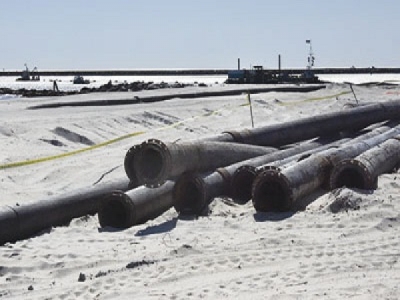
Posted on June 19, 2018
By Charles Swenson, Coastal Observer
Property owners on Pawleys Island will be asked to decide this month how much sand they want on the beach from a nourishment project that could start as early as November.
The town received bids from three firms to pump between 700,000 and 1.1 million cubic yards of offshore sand onto 2.6 miles of beach from the south end to just north of Pawleys Pier. Marinex Construction of Charleston was the low bidder at $10.9 million for the smaller project and $15 million for the larger one.
“I think everyone’s in support of it,” Administrator Ryan Fabbri said. The town plans to fund the work with a combination of local funds accumulated from accommodations tax and a state grant. To complete the smaller project, the town will have to raise an additional $1.2 million. For the larger project, it will need an extra $3.6 million. “I think that’s going to be the discussion, not whether we do it or not,” Fabbri said.
Five firms expressed interest in the project. It was estimated to cost a minimum of $11.8 million, but the town and its consultants have seen prices vary for similar work along the state’s beaches. In addition to the construction cost, the town has to pay another $600,000 for engineering.
Bids from Great Lakes Dredge and Dock, which is currently working in Myrtle Beach, ranged from $15.1 million to $19.3 million. Weeks Marine of Louisiana bid between $12.5 million and $17.6 million.
To make sure a project fit within the available funds, the town sought bids for both the minimum and maximum amounts of sand and for work that would start in November this year or November 2019. Only Weeks Marine bid on the later start, and the price was the same as doing the work this year.
“The great news is that they can do it this year. That’s fantastic,” said Town Council Member Rocky Holliday who chaired the town’s beach committee that recommended going forward with a nourishment project. “It’s a big commitment, but I think we’re ready.”
A meeting with property owners is scheduled for June 29 to review the project. It will qualify Pawleys Island as an “engineered beach” eligible for federal funds to help replace sand lost to erosion from a named storm in a declared disaster. To maintain that designation, the town will have to commit to ongoing beach nourishment projects.
The town also wants to hold a non-binding vote among property owners, as it did several years ago before launching a project to move its electric and cable lines underground.
“The big question is what is the question that you’re going to ask of the property owners,” Holliday said at a council meeting this week.
The cost to mobilize the dredge and other equipment is $2.8 million. The Marinex dredge is smaller than those of the other two companies, said Steven Traynum, the project manager for Coastal Science and Engineering. While that would be a disadvantage in some projects, for Pawleys Island, the offshore sand is in water 25 to 35 feet deep so the smaller dredge is more economical.
In addition, the firm will be working at Folly Beach over the summer. “I think that’s why they gave a favorable price,” Traynum said.
Marinex was also the lowest of the three firms in the cost to place each cubic yard of sand: $10.33.
Since the mobilization cost is fixed, the larger project is the best bargain, Mayor Jimmy Braswell said. The town has arranged to borrow $2.4 million toward the project, backed by its accommodations tax revenue. The town doesn’t have a municipal property tax. It has also been suggested the town could raise private funds for the beach project as it did for the new Town Hall that is currently under construction.
The issue is time, Holliday said. The town needs to notify Marinex by mid-July that it intends to proceed. “We had a lot of time to talk about the funding of Town Hall,” Holliday said.
Fabbri said it is important to explain the details of the project. “A lot of property owners think beach renourishment is us going out there and doing sand scraping again,” he said, referring to the emergency work that followed hurricanes Matthew and Irma. “It is a big operation and it is 24/7.”
After completion, Traynum said, there will be about 100 feet of dry sand beach at high tide in front of houses on the island’s south end, where the water now laps at the porches. That would be the case under both scenarios. The larger volume of sand would extend the time between beach nourishment projects.
Source: Coastal Observer





